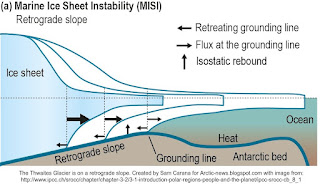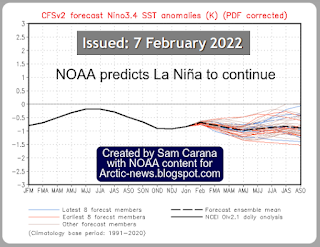Ocean heat is at record levels. As a result, global sea ice extent was only 16.23 million km² on February 9, 2022, the third lowest extent on record. What makes this even more worrying is that we're currently in the depth of a persistent La Niña.
Antarctic sea ice at lowest extent on record since start satellite measurements
Ocean heat is a huge threat for Antarctica at the moment. The image below shows that Antarctic sea ice extent was only 2.091 million km² on February 16, 2022, the lowest on record since the start of satellite measurements.
Ocean heat is reducing the sea ice around Antarctica and is getting underneath floating sea ice.
The Thwaites Glacier, which is on a retrograde slope, is especially vulnerable to collapse.
The Thwaites Glacier contains enough ice to raise global sea levels by 65 cm (25.59 inches) if it were to completely collapse.
The animation on the right, created with images from Climate Reanalyzer, shows the retreat of the Antarctic snow and ice cover from January 5 to February 18, 2021.
The animation underneath, by navy.mil, shows sea ice thickness over 30 days up to February 17, 2022 (with 8 days of forecasts added).
Another danger of a rapid loss of the snow and ice cover on Antarctica is release of methane. Jemma Wadham warned about this in a 2012 study, as discussed at the post methane hydrates. More recently, Jemma Wadham said: “We are sleepwalking into a catastrophe for humanity.”
The Thwaites Glacier is often called the Doomsday Glacier because if it collapses it would lead to vast sea level rise, and scientists believe it is likely to fail within a few years, says Cliff Seruntine (the Naturalist) in the video below.
The Thwaites Glacier is often called the Doomsday Glacier because if it collapses it would lead to vast sea level rise, and scientists believe it is likely to fail within a few years, says Cliff Seruntine (the Naturalist) in the video below.
A recent study concludes that mountain glaciers may hold less ice than previously thought. Their disappearance means less water for drinking and agriculture, and faster temperature rises due to albedo loss. While the study found that the Himalayas contain more water than thought, another recent study, Mt. Everest’s highest glacier is a sentinel for accelerating ice loss, describes how human-induced climate change has a huge impact on the highest reaches of the planet.
The outlook for the Arctic is most threatening, as the post methane hydrates also concluded back in 2013, as described in numerous post here at Arctic-news and as discussed in the video below by Jim Massa.
The outlook for the Arctic is most threatening, as the post methane hydrates also concluded back in 2013, as described in numerous post here at Arctic-news and as discussed in the video below by Jim Massa.
As said, we're currently in the depth of a persistent La Niña, which suppresses temperatures. As the temperature keeps rising, ever more frequent strong El Niño events are likely to occur, as discussed in an earlier post.
A 2019 study analyzes how tipping the ENSO into a permanent El Niño can trigger state transitions in global terrestrial ecosystems.
Currently, the temperature rise is additionally suppressed by low sunspots. Within a few years time, sunspots can be expected to reach the peak of their current cycle and observed sunspots are looking stronger than predicted.
In the image below on the right, adapted from NOAA, the solar cycle is represented as the number of sunspots (top) and F10.7cm radio flux (bottom).
In a recent communication, James Hansen repeats that, as reductions take place in the sulfate aerosols that are currently co-emitted by traffic, transport and industry, this is causing the current temperature rise to accelerate and could cause further rapid global warming, referred to in a 2021 presentation as a termination shock.
Furthermore, in addition to a huge temperature rise resulting from sulfate aerosols falling away, there could be a further rise in temperature as a result of releases of other aerosols with a net warming impact, such as black and brown carbon, which can increase dramatically as more wood burning and forest fires take place.
In summary, while the temperatures are accelerating, we'll soon be moving into the next El Niño, with sunspots moving toward a peak, with sulfate aerosols causing a termination shock and with other aerosols further driving up the temperature rise.
Stop the deception!
In a giant scheme of deception, the temperature rise is all too often presented with images of people playing on the beach on a 'warm' day, as if 'global warming' was making life more 'comfortable'.
Forest fires are called 'wildfires', biomass burning and associated deforestation is referred to as 'renewable biofuel', fracking-induced earthquakes are called 'natural' disasters and methane eruptions are called seeps and bubbles of 'natural' gas from 'natural' sources such as wetlands.
This gives the false impression that this was somehow 'natural' as if human activities had nothing to do with it, and as if owning beach-front property was becoming ever more attractive.
The situation is dire and calls for the most comprehensive and effective action, as described at the Climate Plan.
• Another Record: Ocean Warming Continues through 2021 despite La Niña Conditions - by Lijing Cheng et al.
https://link.springer.com/article/10.1007%2Fs00376-022-1461-3
• Ocean heat is at record levels, with major consequences - by Kevin Trenberth
• Arctic Data archive System - Vishop extent
• IPCC: Marine Ice Sheet Instability
Let's stop this deception! In reality, human-caused emissions have a huge short-term impact on temperature and their combination with genuinely natural variability such as El Niño and sunspots can act as a catalyst, causing numerous feedbacks to kick in with ever greater ferocity.
This can result in collapse of global sea ice and permafrost, resulting in albedo loss and eruption of huge quantities of carbon dioxide, methane and nitrous oxide, further driving up the temperature rise abruptly, as described at the extinction page. Further feedbacks are also described at the feedbacks page.
Conclusion
Links
https://link.springer.com/article/10.1007%2Fs00376-022-1461-3
• NSIDC: Charctic Interactive Sea Ice Graph
• Climate Reanalyzer
https://climatereanalyzer.org/wx/DailySummary/#seaice-snowc-topo
• Antarctica CICE ice thickness
• Antarctica’s ‘doomsday’ glacier: how its collapse could trigger global floods and swallow islands
• NOAA - Monthly Temperature Anomalies Versus El Niño
• Human Extinction by 2022?
• Tipping the ENSO into a permanent El Niño can trigger state transitions in global terrestrial ecosystems - by Mateo Duque-Villegas et al. (2019)
• Antarctica CICE ice thickness
https://theconversation.com/antarcticas-doomsday-glacier-how-its-collapse-could-trigger-global-floods-and-swallow-islands-173940
• Methane hydrates (2013)
• A new frontier in climate change science: connections between ice sheets, carbon and food webs (2021)
• Human-induced climate change impacts the highest reaches of the planet — Mount Everest
• Ocean Heat Content Update 1 - 2022 - Science Talk with Jim Massa
https://www.youtube.com/watch?v=pctkg_LDqcU
• Potential methane reservoirs beneath Antarctica - by Jemma Wadham et al. (2012)
https://www.nature.com/articles/nature11374
https://www.nature.com/articles/nature11374
• Ice velocity and thickness of the world’s glaciers - by Romain Millan et al.
https://www.nature.com/articles/s41561-021-00885-z
• Mountain glaciers may hold less ice than previously thought – here’s what that means for 2 billion downstream water users and sea level rise
https://theconversation.com/mountain-glaciers-may-hold-less-ice-than-previously-thought-heres-what-that-means-for-2-billion-downstream-water-users-and-sea-level-rise-176514
• Mountain glaciers may hold less ice than previously thought – here’s what that means for 2 billion downstream water users and sea level rise
https://theconversation.com/mountain-glaciers-may-hold-less-ice-than-previously-thought-heres-what-that-means-for-2-billion-downstream-water-users-and-sea-level-rise-176514
• Mt. Everest’s highest glacier is a sentinel for accelerating ice loss - by Mariusz Potocki et al.
• Ocean Heat Content Update 1 - 2022 - Science Talk with Jim Massa
https://www.youtube.com/watch?v=pctkg_LDqcU
• NOAA - ENSO: Recent Evolution,
Current Status and Predictions
https://www.cpc.ncep.noaa.gov/products/analysis_monitoring/lanina/enso_evolution-status-fcsts-web.pdf• Human Extinction by 2022?
https://esd.copernicus.org/articles/10/631/2019
• NOAA - Solar Cycle Progression
• James Hansen - The New Horse Race
• Climate Impact of Decreasing Atmospheric Sulphate
Aerosols and the Risk of a Termination Shock - by Leon Simons, James Hansen and Yann duFournet (2021)
• NOAA - Solar Cycle Progression
• Aerosols
• Feedbacks
• Extinction

















































